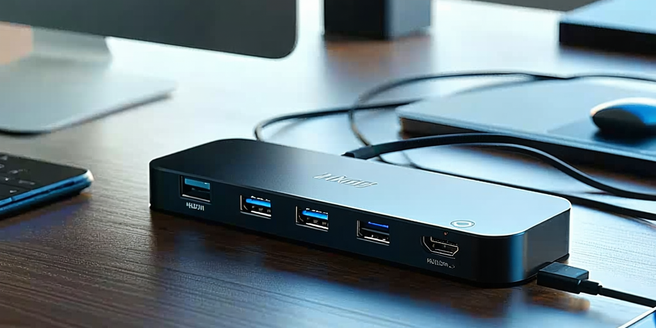Multi-port Hubs For Connectivity

Understanding Multi-port Hubs
Multi-port hubs serve as crucial devices in modern digital setups, allowing multiple connections through a single port. These hubs improve efficiency by enabling data transfer between various devices simultaneously. They can often include USB, HDMI, Ethernet, and audio ports, accommodating the diverse needs for linking peripherals. Initially developed to address connectivity challenges in growing workplaces, multi-port hubs streamline and expand the capability of existing systems. Their importance has surged with the rise of remote work, where functionality and manageability of equipment are paramount. Understanding the spectrum of devices with which these hubs interact will enhance any tech strategy.
Key Features of Modern Hubs
Modern multi-port hubs are renowned for their features, designed to optimize user experience. Key attributes include high-speed data transfer, compact and portable designs, and broad compatibility. With robust versatility, these hubs cater to a wide range of devices and technological requirements. They are engineered to support several interfaces including USB-C, Thunderbolt, and legacy ports like USB-A. Some hubs offer power delivery features, ensuring that mobile devices charge while connected. High-definition display support is another highlight, often providing smoother visuals through HDMI or DisplayPort. Feature-rich hubs balance power, connectivity, and performance, ensuring users can seamlessly switch between tasks, ultimately meeting diverse needs without overwhelming the workspace layout.
Advantages of Using Multi-port Hubs
Utilizing multi-port hubs provides a range of advantages that enhance productivity. By consolidating multiple ports into one convenient device, users experience a decluttered workspace. This facilitates better cable management and simplifies connections between devices. The hubs often support fast data transfer speeds, crucial for tasks like backing up large files, playing high-resolution media, or running complex applications. Additionally, they contribute to energy efficiency by reducing the number of power-hungry adapters needed. They also expand hardware capabilities, enabling older laptops to work with the latest peripherals. This versatility makes multi-port hubs ideal for both office and home offices, supporting a dynamic environment without the need for excessive wiring.
Choosing the Right Multi-port Hub for Your Needs
Selecting the appropriate multi-port hub involves assessing your specific requirements and existing technology. Consider the number of devices you need to connect and the types of ports required. Compatibility with your current hardware, such as laptops or smartphones, is crucial. Evaluate the power supply needs, especially if you require a hub that can charge devices simultaneously. Consider factors such as portability and durability; for frequent travelers, a lightweight and robust design is ideal. Additionally, contemplate the video output capabilities if you need to connect to external displays. Tailoring these factors to your personal setup ensures optimal functionality.
Compatibility Considerations for Multi-port Hubs
When investing in a multi-port hub, compatibility is key to ensuring seamless integration with your devices. Check the operating system requirements; some hubs offer full features only with recent versions of operating systems. Furthermore, read reviews from other users to gain insights into the practical functionality of the hub. Additionally, verify that your devices support the connection standards of the hub, such as USB-C or Thunderbolt 3. Consider the bandwidth requirements of your peripherals to avoid bottlenecks. Keep an eye on power delivery capabilities if you plan to charge equipment through the hub. Ensuring compatibility not only maximizes the efficiency of your hub but also avoids connectivity issues.
Troubleshooting Common Multi-port Hub Issues
When encountering issues with multi-port hubs, several troubleshooting steps can help. Begin by checking all connections and ensuring they are tight and secure. If a device is not recognized, try connecting it directly to your main device to verify its functionality. It is also important to identify if the problem is consistent across other devices connected to the hub. Update drivers or firmware for both the hub and connected devices, as outdated software can cause incompatibility. Examine power supply to the hub, ensuring it meets the requirements. If the hub overheats, make sure it is used in a well-ventilated area. Practicing these steps can often resolve issues and restore smooth operation.